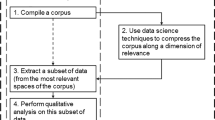Abstract
We propose a novel probabilistic method, based on latent variable models, for unsupervised topographic visualisation of dynamically evolving, coherent textual information. This can be seen as a complementary tool for topic detection and tracking applications. This is achieved by the exploitation of the a priori domain knowledge available, that there are relatively homogeneous temporal segments in the data stream. In a different manner from topographical techniques previously utilized for static text collections, the topography is an outcome of the coherence in time of the data stream in the proposed model. Simulation results on both toy-data settings and an actual application on Internet chat line discussion analysis is presented by way of demonstration.
Similar content being viewed by others
References
Allan, J., Carbonell, J., Doddington, G., Yamron, J., and Yang, Y. (1998). Topic Detection and Tracking Pilot Study Final Report. In Proc. of DARPA Broadcast News Transcription and Understanding Workshop, Feb. 1998 (pp. 194–218).
Attias, H. (1999). Independent Factor Analysis. Neural Computation, 11(4), 803–851.
Beeferman, D., Berger, A., and Lafferty, J. (1999). Statistical Models for Text Segmentation. In C. Cardie and R. Mooney (Eds.), Machine Learning, Special Issue on Natural Language Learning, 34(1–3), 177–210.
Bishop, C.M., Hinton, G.E., and Strachan, I.G.D. (1997). GTM Through Time. In Proc. IEE Fifth International Conference on Artificial Neural Networks, IEE, London (pp. 111–116).
Bishop, C.M., Svensen, M., and Williams, C.K.I. (1998). GTM: The Generative Topographic Mapping. Neural Computation, 10(1), 215–235.
Deerwester, S., Dumais, S.-T., Furnas, G.-W., Landauer, T.-K., and Harshman, R. (1990). Indexing by Latent Semantic Analysis. J. Amer. Soc. Inf. Sci, 41(6), 391–407.
Ghahramani, Z. and Beal, M.J. (To appear). Graphical Models and Variational Methods. In Saad &; Opper (Eds.), Advanced Mean Field Method—Theory and Practice. Cambridge, MA: MIT Press.
Girolami, M. (2001). Latent Class and Trait Models for Data Classification and Visualisation. Invited Chapter for book ‘ICA: Principles and Practice’, Cambridge University Press.
Hollmén, J. and Tresp, V. (1999). Call-Based Fraud Detection in Mobile Communications Networks Using a Hierarchical Regime-Switching Model. In M. Kearns, S. Solla, and D.A. Cone (Eds.), Neural Information Processing Systems, Vol. 11 (pp. 889–895). Cambridge, MA: MIT Press.
Hyvarinen, A. (To appear). Complexity Pursuit: Separating Interesting Components from Time-Series. Neural Computation.
Jebara, T., Ivanov, Y., Rahimi, A., and Pentland, A. (2000). Tracking Conversational Context for Machine Mediation of Human Discourse. In AAAI Fall 2000 Symposium—Socially Intelligent Agents—The Human in the Loop, Nov. 2000.
Kabán, A. and Girolami, M. (in press). A Combined Latent Class and Trait Model for the analysis and visualization of Discrete Data. IEEE Transactions on Pattern Analysis and Machine Intelligence.
Kimber, D. and Bush, M. (1993). Situated State Hidden Markov Models. ICASSP.
Lagus, K., Honkela, T., Kaski, S., and Kohonen, T. (1999). WEBSOM for Textual Data Mining. Artificial Intelligence Review, 13(5/6), 345–364.
McCallum, A. and Nigam, K. (1998). A Comparison of Event Models for Naive Bayes Text Classification. In Proc. of AAAI/ICML-98 Workshop on Learning for Text Categorization (pp. 41–48).
McCullagh, P. and Nelder, L.A. (1985). Generalized Linear Models. London: Chapman and Hall.
McLachlan, G. and Peel, D. (2000). Finite Mixture Models. New York: John Wiley &; Sons.
Rabiner, L.R. (1989). A Tutorial on Hidden Markov Models and Selected Applications in Speech Recognition. In Proc. of the IEEE, 77(2), 257–285.
Roweis, S. (1999). Constrained Hidden Markov Models. In Neural Information Processing Systems, Vol. 12 (NIPS'99) (pp. 782–788).
Sahami, M. (1998). Using Machine Learning to Improve Information Access. Ph.D. Thesis, Stanford University.
Salton, G. and McGill, M. (1983). Introduction to Modern Information Retrieval. New York: McGraw-Hill.
Sammon, J.W. (1969). A Nonlinear Mapping for Data Structure Analysis. IEEE Transactions on Computers, C-18(5), 401–409.
Saul, L. and Roweis, S. (2000). Nonlinear Dimensionality Reduction by Local Linear Embedding. Science.
Tenenbaum, J.B. (1997). Mapping a Manifold of Perceptual Observations. In Advances in Neural Information Processing Systems, Vol. 10 (NIPS'97).
Valpola, H. (2000). Unsupervised Learning of Nonlinear Dynamic State-Space Models, Publications in Computer and Information Science A59, Helsinki University of Technology, Espoo, Finland.
Yamron, J. (1998). Topic Detection and Tracking Segmentation Task. In Proc. of Broadcast News Transcription and Understanding Workshop.
Author information
Authors and Affiliations
Rights and permissions
About this article
Cite this article
Kabán, A., Girolami, M.A. A Dynamic Probabilistic Model to Visualise Topic Evolution in Text Streams. Journal of Intelligent Information Systems 18, 107–125 (2002). https://doi.org/10.1023/A:1013673310093
Issue Date:
DOI: https://doi.org/10.1023/A:1013673310093




